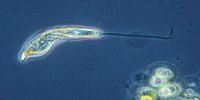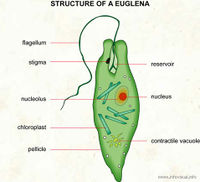Difference between revisions of "Flagellates"
| Line 6: | Line 6: | ||
===''Euglena''=== | ===''Euglena''=== | ||
| − | [[File:Euglena.jpg| | + | [[File:Euglena.jpg|right|200px|Euglena [9]|thumb]] |
:Like all [[Flagellates]], Euglena have a flagellum. They are green because they have chloroplasts, which are organelles that aid in photosynthesis and contain chlorophyll. They have a plasma membrane, which contains their cytoplasm and other organelles. The pellicle is a flexible membrane, which supports the plasma membrane. A contractile vacuole removes excess water from the cell, and a reservoir located near the flagellum expels the excess water. They also have a red eye spot, called a stigma, which is light sensitive and helps to guide their movement. | :Like all [[Flagellates]], Euglena have a flagellum. They are green because they have chloroplasts, which are organelles that aid in photosynthesis and contain chlorophyll. They have a plasma membrane, which contains their cytoplasm and other organelles. The pellicle is a flexible membrane, which supports the plasma membrane. A contractile vacuole removes excess water from the cell, and a reservoir located near the flagellum expels the excess water. They also have a red eye spot, called a stigma, which is light sensitive and helps to guide their movement. | ||
Revision as of 14:09, 5 May 2021
Overview
Flagellates are unicellular microorganisms and are a part of the protozoa group. They are characterized by having one or more flagella, which is a hair-like whip organelle and very distinguishable. There are many different types of flagellates, and they all have different lifestyles. Some make up colonies and others live as single cells. The two main categories are phytoflagellates and zooflagellates. Phytoflagellates are green and plant-like creatures that use photosynthesis to produce food. Zooflagellates are colorless and animal-like. Parasitic flagellates also fall into this category.
Both phytoflagellates and zoolagellates can be found in ponds, lagoons, and even shallow puddles. Wherever there are large amounts of soluble food, flagellates can thrive. However, parasitic zooflagellates live inside the intestines or bloodstream of a host and can cause harmful diseases like giardiasis.
Examples
Euglena
- Like all Flagellates, Euglena have a flagellum. They are green because they have chloroplasts, which are organelles that aid in photosynthesis and contain chlorophyll. They have a plasma membrane, which contains their cytoplasm and other organelles. The pellicle is a flexible membrane, which supports the plasma membrane. A contractile vacuole removes excess water from the cell, and a reservoir located near the flagellum expels the excess water. They also have a red eye spot, called a stigma, which is light sensitive and helps to guide their movement.
Volvox
- A Volvox is a colony of freshwater algae that forms a hollow ball and can be made up of anywhere from 500-200,000 individual cells. Their flagella are pointed outward, and they move together as one in a spinning motion. They can be big enough to see with the naked eye. The Flagellates are connected by thin strands of cyptoplasm, and can be green, red, or brown.
Parasites
- Parasitic Flagellates are categorized under the name Zooflagellates because they do not have the means to produce their food through photosynthesis. One example of a parasitic Flagellate is Giardia. Giardia causes disease in humans when their cyst form is ingested through contaminated water. The cyst form serves as a protective dormant state for Giardia until it enters a host's small intestine, causing diarrhea and malabsorption. Some cyst form Giardia pass through the host's system, allowing it to infect others.
Reproduction
- Flagellates reproduce asexually, but in some cases, like that of the Volvox colony, they can reproduce sexually as well. The form of asexual reproduction is binary fission. This is the process where the organism duplicates its DNA and splits into two daughter cells. Most flagellates use this process. A Volvox uses a slightly different process. In the center of the colony, there are spheres which are colonies of daughter cells. These cells come from the middle of the colony, and undergo many cell divisions until they form a sphere. They are held inside the Volvox until the parent disintegrates and the daughter cells turn their flagella outward to become the new colony.
References
- [1] Adam, Rodney D. “Body of Giardia Lamblia.” American Society for Microbiology, July 2001. [1]
- [2] Bailey, Regina. “Eugena Cells.” ThoughtCo, 26 Jan. 2018, [2].
- [3] Fiegl, Madison, and JD French. “Volvox Cateri.” Microbe Wiki, 28 Apr. 2018, [3].
- [4] "Flagellates.” Environmental Leverage, 2003, [4].
- [5] “Flagellate (Protozoan).” Assignment Point, [5].
- [6] Palande, Leena. “Volvox Facts.” Biology Wise, [6].
- [7] “Protozoan Parasites.” Para-Site, [7].
- [8] Setia, Veenu, and Thinley Kalsang Bhutia. “Flagellate.” Britannica, 28 Mar. 2018, [8].
- [9] “The Structure and Illustration of Euglena.” Dreams Time, [9].



